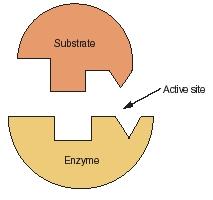- Cells are able to build up and break down their proteins, lipids and carbohydrates or change one to the other.
- Eg. Animals cells build up glycogen from glucose.
- all cells can make proteins from amino acids and they can build up fats from glycerol and fatty acids.
- Animals cannot make proteins unless they are supplied with amino acids.
- Plants can make their own amino acids starting from sugar and salts.
………………………………………………………………………………….
 Lock and key model
Lock and key model
http://www.scienceclarified.com/images/uesc_05_img0235.jpg
세포안에서는 수많은 물질들이 합쳐졌다가도 분해되기도 한다. 이런 chemical reactions의 속도를 맞추어주는것이 enzyme의 기능이다. Enzyme이 작용하기 위해서는 알맞는 온도와 pH가 맞아야만 하고, active site(접착기면)에 substrate(기질)이 정확이 맞아야만 한다.
Substrate가 자기만의 모양을 가지고 있듯이 화학 반응이 일어나는 표면인 active site또한 자신만의 모양을 가지고있다. 퍼즐과 퍼즐이 맞아떨어저야 그림을 이루듯, 이 두가지가 정확이 맞아떨어질때 반응이 일어나는것이다.
………………………………………………………………………………….
Enzymes are proteins that act as biological catalysts.
- made in the cells
- catalyst is a chemical substance that speeds up a reaction but does not get used up during the reaction.
- anabolic enzyme reaction = join two other molecules together and form a more complicated substance. Large molecules are built up from smaller molecules.
- Catabolic enzyme reaction = split large molecules into smaller ones.
Enzymes을 공부할땐 5가지를 꼭 기억해서 외우자.
1. Enzymes and temperature:
A rise in temperature increases the rate of most chemical reactions. A fall in temperature slows down. However, if the temperature is too high for the enzyme (eg. above 50’C) protein can be denatured and stop working. The shape of an enzyme molecule is very important if it has to fit the substances on which it acts.
2. Enzymes and pH:
Acid and alkaline conditions alter the chemical properties of enzyme. Most enzymes work best at particular level of acidity or akalinity (pH).
3. Enzymes are specific for substrates:
Enzyme that normally acts on one substance will not act on a different one.
4. Rates of enzyme reaction:
- depends on the temperature and pH
- concentration of the enzyme and its substrate
5. Intra- and extracellular enzymes: All enzymes are made inside cells. Most of them remain inside the cell to speed up reactions in the cytoplasm and nucleus.
